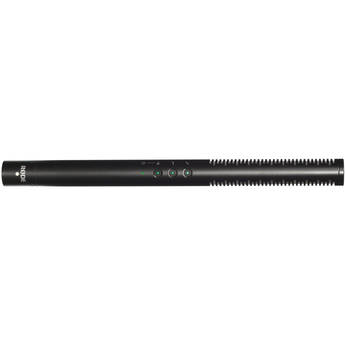Audio Hiss Noise Reduction
https://youtu.be/1lIjFBG6w58 Sometimes I find that my audio has audible hiss in the background. This is often what is described as a noise floor and is the hiss produced by your microphone, preamplifier, cable, or possibly other things. In any case, it isn’t an awesome sound.
In this episode we look at one way to reduce that hiss in your dialogue audio without affecting the dialogue and we’ll use Adobe Audition CC (2014) to show you how.
The clip with the hiss was recorded with a RØDE NTG-2 shotgun microphone, compressed and loudness normalized to -19 LUFS (since it was a mono file, this is the perceptual equivalent of -16 LUFS for stereo files). I hadn't really noticed this much noise in this mic in the past. And this was all recored as I'm starting to evaluate the new RØDE NTG4+ which I received a few days ago. So far, I'm wondering if maybe there's something wrong with my copy of the NTG4+. RØDE is arranging for an engineer to contact me so we can figure out what's going on with this new mic so it may be a few more weeks before we can publish that review.
Tascam DR-70D Special Pricing
 Looks like B&H has special pricing on the Tascam DR-70D, the "big brother" of the DR-60DmkII. This has four XLR inputs and built-in mics. Pretty good deal for those that need 4 XLR inputs. Normally priced at $300 USD, now $250. Not sure how long this pricing lasts.
Looks like B&H has special pricing on the Tascam DR-70D, the "big brother" of the DR-60DmkII. This has four XLR inputs and built-in mics. Pretty good deal for those that need 4 XLR inputs. Normally priced at $300 USD, now $250. Not sure how long this pricing lasts.
Atomos Shogun and Panasonic GH4
https://youtu.be/6K1Z_nhFm9Q I've been shooting with the Atomos Shogun and Panasonic GH4 since late December and wanted to answer a few questions I've received about this combination.
This is my first Google Hangouts on Air. A little rough around the edges and some lessons learned but hopefully this is helpful for those that want to know about this combination.
Dialogue Audio Compression
https://youtu.be/swdCWYskbpA How can you get clear, clean, present dialogue audio for your film or video projects? There are several things you can do but one of the fundamental things is to use a compressor. An audio compressor levels out your audio so that the loudest parts are not too much louder than the softer parts. Once you have compressed your dialogue audio, you can then apply a variety of other effects and at the end, loudness normalize it so that it is loud enough for playback for your audience.
This is another case where I used my trusty old Shure SM-58 and Focusrite Saffire Pro 24 DSP (audio interface) to record voice over. Not a horrible choice for that, I think. I use the real-time DSP compressor on the Focusrite so that I don't have to do quite as much work in post to get the voice over cleaned up and loudness normalized. Very old-school of me.
Fix Audio Clipping in Audition
http://youtu.be/IHXDtiRYdeM Have you ever run into a case where you finished shooting and thought everything was good with your audio but when you download all of your audio files and footage, find that some of the audio is clipped and distorted? Not super bad, but just a few clips here and there? I have and so I tried putting Adobe Audition’s de-clipper to work to see if we could fix that. And it turns out that it works reasonably well if you have relatively mild clipping so you can save your audio from the digital audio distortion demons!
Aspen Mics HQ-S: Yet Another Cheap Lavalier Microphone
http://youtu.be/hkLVtPksn2I Let’s have a listen to another affordable lavalier microphone! This is the Aspen Mics HQ-S. The “S” stands for stereo. But don’t let that give the wrong impression because this is a mono mic that sends the same sound to both channels on a stereo recorder or camera with a stereo input. That just saves you some time in post but also comes at a little bit of a cost. This mic is not quite as sensitive as some of its mono competitors that only record to one channel like the JK MicJ 044. In this case we’ll compare the Aspen to the Giant Squid and JK lavalier mics.
If you really want to reduce the amount of work you have to do in editing, you really probably need to look at better microphones. None of these mics are through-the-roof amazing. But they all are decent and far better than relying on your camera’s microphone.
So pick the one that suits your editing needs—one with a TRS plug if you don’t want to bother with dropping the silent channel in editing at the cost of less sensitivity. Or the other with more sensitivity but that requires you to drop the silent channel in editing.
If you’re not sure how to delete a silent channel, have a look at this previous episode where we quickly run through how to do that. Hint: it is very simple and costs you hardly any time which is why if I had to choose, I’d go with the more sensitive mic and delete the silent channel in editing.
Thanks for the Feedback!
 Wow! Over 90 responses to our last episode where we asked what you wanted to learn about next. And the funny thing? The answer is pretty much, "Yes, all of the above!"
Wow! Over 90 responses to our last episode where we asked what you wanted to learn about next. And the funny thing? The answer is pretty much, "Yes, all of the above!"
So that's good news to me. It means that all these ideas I've had running through my head are pretty much in line which what you all would like to cover!
We have the first one on order: the RØDE NTG4+. It should arrive some time in March and we should have that review posted somewhere near the end of the month.
Then in April we should see the RØDELink wireless lavalier system. This one is quite interesting. I don't think we'll see pros that work in certain situations move to this new kind of wireless system right away, but maybe I'm wrong about that. What makes this different is that it uses the 2.4Ghz range, the same range that most WiFi networks use. The other wireless systems on the market that have been in use for many years use UHF frequencies. Apparently, the FCC in the US is looking at re-allocating some of those frequencies to other purposes so its going to be rough for some in the next little bit.
With these new wireless systems that use the 2.4Ghz range, on the other hand, you have to potentially worry about interference from WiFi and other consumer electronics (like cordless phones) interfering.
Ty Ford recently posted a test he did with a similar system: The Audio Technica System 10 wireless lavalier system which recently introduced a DSLR receiver for their kit which retails for around $450 USD. The main down-side to the Audio Technica System is that it doesn't use a standard plug for the mic so you're committed to using AT's mics.
In any case, Ty said that he was able to shoot several hours with the AT system 10 and did not have a single drop-out. That's pretty impressive.
But before we completely nerd out on audio gear again, we'll first cover the Atomos Shogun. Again, not a full review because there have been a bunch of those already. But more a discussion on what it does for one's workflow. I'm finding that 4k is a lot more expensive than just buying a Panasonic GH4...
And of course Audition and Resolve were popular votes as well. We've got plenty to cover there as well as we dive in and learn more on the audio and color fronts.
So thanks again for your input! We've got lots of exciting things to cover in the next few months!
What Should We Cover Next?
http://youtu.be/fAXq4qDN0Jk In this quick update we talk about some of the things we’ll cover in the next few weeks and ask you to vote on what you’d like to see in the future: DaVinci Resolve color correction and color grading or audio processing in Adobe Audition? RØDELink Wireless lavalier microphone system or RØDE NTG4+ shotgun microphone?
Our upcoming episodes include a new cheap lavalier mic comparison: The Aspen Mics HQ-S versus the Giant Squid and JK MicJ 044 lavalier microphones, each with 3.5mm plugs for recorders (like Zoom H1) or cameras. Then a look at the video features of the Sony a5100 interchangeable lens mirrorless camera with an APS-C sensor. Interesting little camera with impressive video quality. Then we'll probably have a look at the Atomos Shogun. This will not be a full review but more a look at what types of workflows it works for.
So sound off in the comments! Let's hear which topic you'd like to cover first!
Phone Video + Lavalier Mic
http://youtu.be/Q0dRVx_BmtQ Can you record video with your phone and at the same time, record the audio with an external lavalier microphone like the RODE smartLav+? Yes! And you can do this with pretty much any smartphone and almost any lavalier microphone that has a 3.5mm plug. Check out the episode on YouTube for links to the mics and adapters.
RODE NTG-4 and NTG-4+: Innovative New Affordable Shotguns for Enthusiasts
 And speaking of RODE, they also just announced two new Shotgun mics for enthusiast filmmakers: The NTG-4 and NTG-4+. These sit between their NTG-2 (an approximately $220 USD mic) and their professional NTG-3 (a $700 USD mic). The feature set includes several nice little upgrades from the NTG-2, my workhorse shotgun:
And speaking of RODE, they also just announced two new Shotgun mics for enthusiast filmmakers: The NTG-4 and NTG-4+. These sit between their NTG-2 (an approximately $220 USD mic) and their professional NTG-3 (a $700 USD mic). The feature set includes several nice little upgrades from the NTG-2, my workhorse shotgun:
- Super Cardioid Broadcast Quality Sound
- Low Noise Circuitry
- Condenser Transducer
- Rugged Metal Construction
- On-Board Power Button and LED
- High Frequency Boost Button
- High Pass Filter (Flat or 75 Hz)
- -10 dB PAD Button
- Low Handling Noise
And then the NTG-4+ also has a built-in LiOn battery that apparently powers the mic for 150 hours and includes a USB port so that you can charge it nearly anywhere (including in your car)
But the thing that intrigues me most about this is the newly designed capsule that is apparently not quite as bright as many other microphones. You know, that brittle, sibilant sound that many modern mics produce? But then if you need a little more sparkle, you can always turn on the high frequency boost feature built into the mic. That sounds pretty handy!
Another item to put into my "To review" pile...


